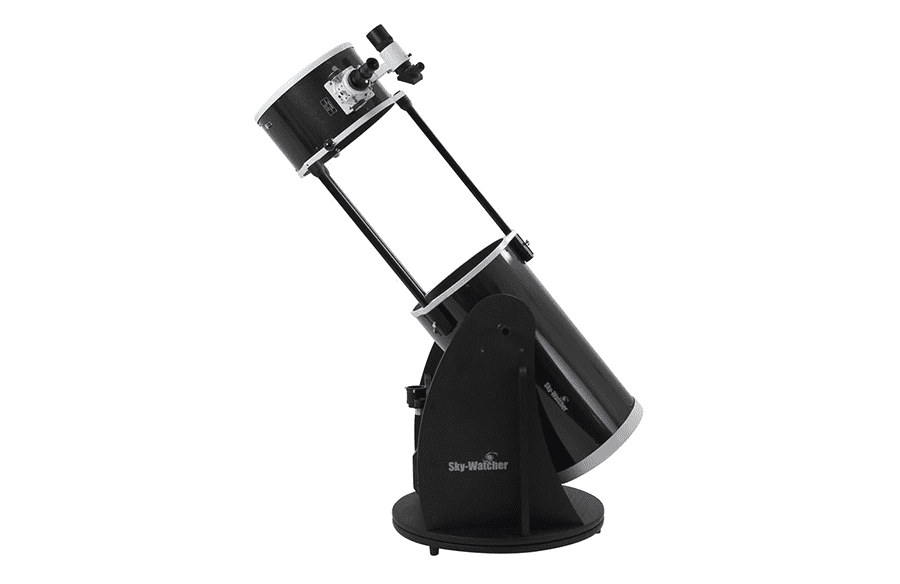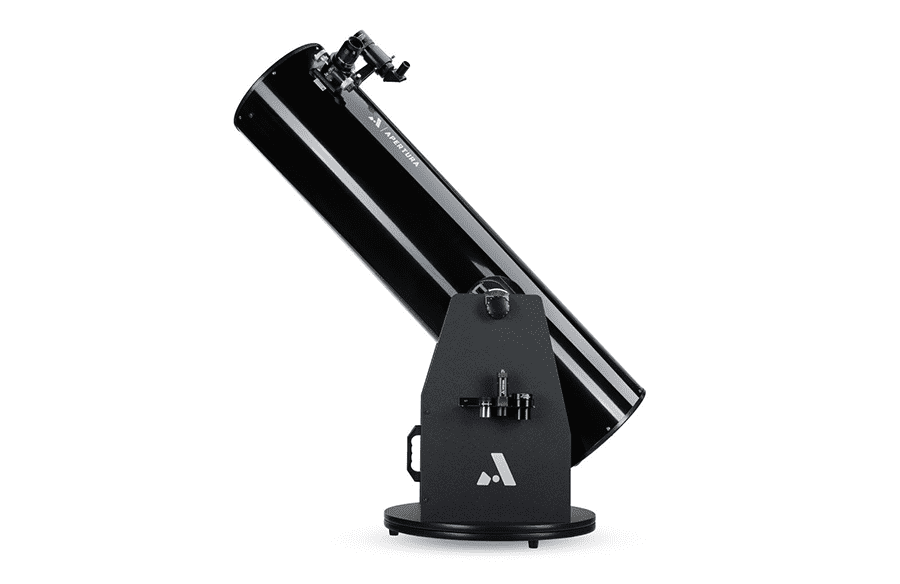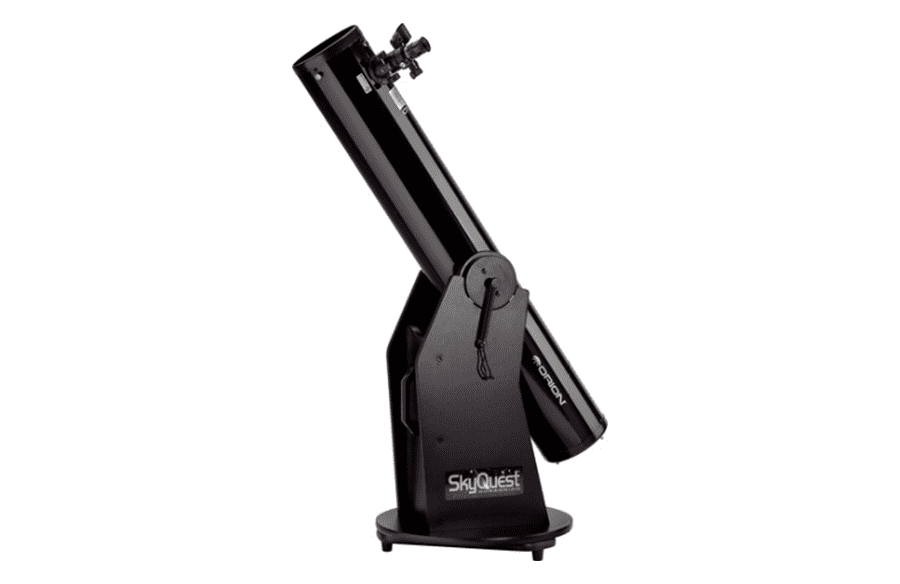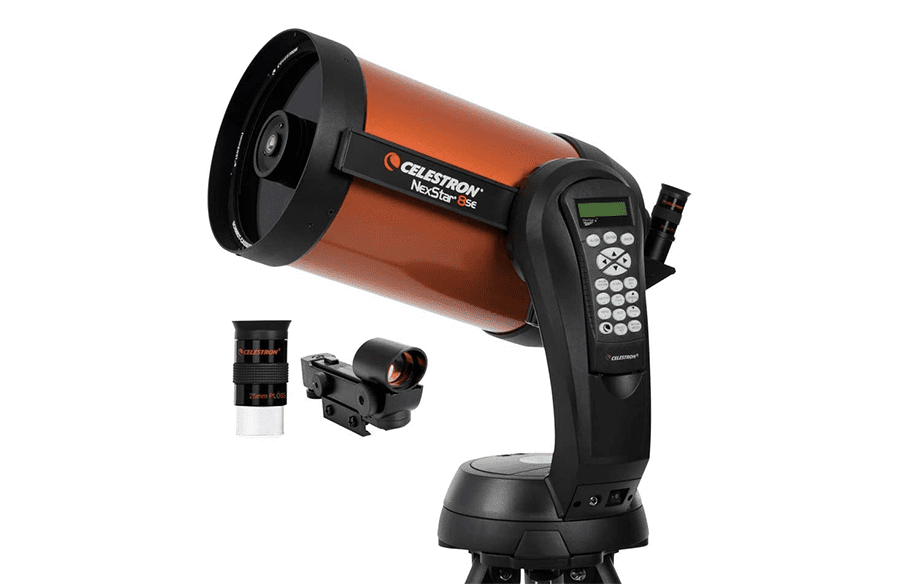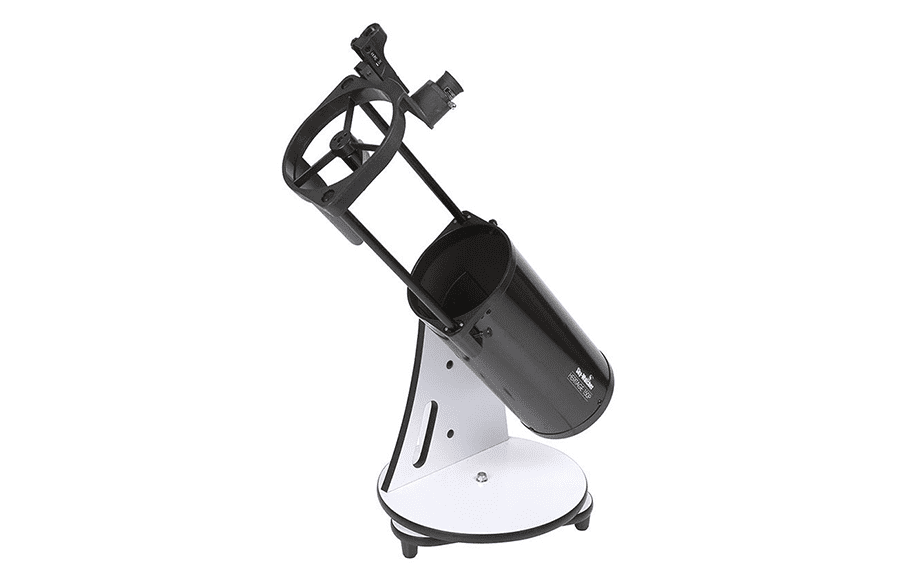The Sky-Watcher Flextube 300P is the best choice for those who are looking for the perfect equilibrium between huge aperture and portability.
BENEFITS
- Collapsible flextube design makes this more portable than other options on this list
- Great quality optics make for sharp, resolved views through the eyepiece
- Huge aperture gives superior light gathering as compared to smaller scopes on this list
- Tension control handle allows for proper balancing and precise slewing and tracking
Apertura AD12 Dobsonian Telescope
We found the Apertura AD12 to be a great balance between cost, build quality, and abundant aperture.
BENEFITS
- Great quality optics make for sharp, resolved views through the eyepiece
- Two quality eyepieces included give great views and a range of magnifications right out of the box
- Massive aperture allows for superior light gathering as compared to others on this list
- Easy set up and use means you can get ready for observing in no time
Orion SkyQuest XT6 Classic Dobsonian Telescope
The Orion SkyQuest XT6 Classic Dobsonian Telescope may be one of the smaller ones on this list, but its features and price point make it a great choice.
Benefits:
- Relatively inexpensive price point is great for those on a budget
- Simple to set up and use, making it great for beginners
- Easy collimation makes setup times even shorter
- 34.4lbs assembled weight allows for better portability and handling than other telescopes on this list
The Celestron NexStar 8SE is a splendid choice for those who want computerization, high magnification, and/or want to do planetary astrophotography.
Benefits:
- Computerized slewing and tracking saves time by finding objects for you
- 2032mm focal length packs a punch on planets and smaller deep sky objects
- Short tube footprint makes this telescope easy to carry around or fit in a case
- Low maintenance and easy collimation makes this a great scope for beginners
The Sky-Watcher Heritage 150P is the best budget and most portable option on this list.
Benefits:
- Inexpensive to buy for anyone on a budget
- Collapsible tube and tabletop style allows for superior portability
- Largest aperture you can find at this price point ensures you are getting the best value for your dollar
- Good included accessories mean you don’t have to go hunting for replacements
When it comes to purchasing a deep space telescope, there are many different facets to think about. In this article, we will go through the top five best telescopes for deep space on the market, as well as go over what makes a good deep space telescope and some important tips for observing.
In our picks, we factored in cost, aperture, and portability in order to give guidance on the best all-around telescope that really performs in deep space. Through our research, we have concluded that the best telescope for seeing deep space objects is the Sky-Watcher Flextube 300P.
Contents
Sky-Watcher Flextube 300P
The Sky-Watcher Flextube 300P is the best choice for those who are looking for the perfect equilibrium between huge aperture and portability.
BENEFITS
- Collapsible flextube design makes this more portable than other options on this list
- Great quality optics make for sharp, resolved views through the eyepiece
- Huge aperture gives superior light gathering as compared to smaller scopes on this list
- Tension control handle allows for proper balancing and precise slewing and tracking
The Sky-Watcher Flextube 300P is one of the largest manufactured telescopes you can find on the market today. However, the benefit to this one is its collapsible truss tube, meaning that it can retract from its full extension of 55” (140cm) down to 36” (91cm) for easy transport in the seat of a car. The flextube is also designed in a way where collimation doesn’t have to be adjusted as frequently as with a regular truss tube telescope.
Included with the telescope are two Plossl eyepieces, 25mm and 10mm respectively, along with an 8×50 RACI finderscope. The accessories are nothing to write home about, but they’re not particularly bad either. We recommend buying some 2-inch eyepieces and a zero-power finder like a Telrad or a red dot finder to open up the field-of-view and really make this telescope shine.
You may also want to invest in a shroud to cover the gap between the upper and lower tube assembly to keep dust and debris out, as well as keep stray light out to maintain a solid contrast between the background and the object being viewed.
Besides that, the Sky-Watcher Flextube 300P is a wonderful telescope for the price, and therefore is our top pick here at Optical Mechanics.
We found the Apertura AD12 to be a great balance between cost, build quality, and abundant aperture.
BENEFITS
- Great quality optics make for sharp, resolved views through the eyepiece
- Two quality eyepieces included give great views and a range of magnifications right out of the box
- Massive aperture allows for superior light gathering as compared to others on this list
- Easy set up and use means you can get ready for observing in no time
The Apertura AD12 is certainly one of the more impressive consumer-grade telescopes available on the market today. It’s big, it’s bulky, but it packs a ton of aperture, giving a great observing experience of bright and dim deep sky objects alike.
In order to lug this telescope around, you’ll need to accommodate quite a bit of room in your car, since the optical tube is 58 inches (1.5m) in length and weighs about 48 pounds (22kg). This can be an inconvenience to some who may not have a larger vehicle or the strength to lift the optical tube.
In the box, the Apertura AD12 comes with two eyepieces (30mm & 9mm), along with a 9×50 right angle finderscope, a laser collimator, and a 1.25” moon filter. The two included eyepieces are great optically, but we recommend investing in an eyepiece between the two (~14mm-20mm) for when you want higher magnification than the 30mm provides, but the atmosphere is not quite still enough for the 9mm to be sharp.
The included 9×50 finderscope can also prove to be difficult to use for beginners, since it’s magnified and can be difficult to see the crosshairs in the dark. With that being said, we also recommend investing in a zero-power finder like a Telrad or a simple red dot finderscope.
The Orion SkyQuest XT6 Classic Dobsonian Telescope may be one of the smaller ones on this list, but its features and price point make it a great choice.
Benefits:
- Relatively inexpensive price point is great for those on a budget
- Simple to set up and use, making it great for beginners
- Easy collimation makes setup times even shorter
- 34.4lbs assembled weight allows for better portability and handling than other telescopes on this list
The Orion SkyQuest XT6 is one of the smaller telescopes on this list, but is great for anyone just getting into astronomy who wants to have a great telescope to use for years to come without breaking the bank.
Out of the box, the XT6 does not come with very many accessories, only including one 25mm Plossl and a red dot finderscope. To get the full potential out of this telescope, it is recommended that you purchase some higher magnification eyepieces (10mm, 14mm, etc.)
The great thing about this telescope is that it’s very simple to collimate and can just easily be transported in the back seat of a car and plopped down onto its mount. Being such a small primary mirror, the cooldown time for it is relatively low compared to the other telescopes listed here as well.
However, one of the main downfalls of this telescope is the plastic rack-and-pinion focuser that comes stock on the telescope. In terms of build quality, it is ok, but it’s not as smooth as the aluminum crayford focusers featured on other telescopes, and only supports 1.25” eyepieces. Unfortunately, this isn’t really a thing that can be easily upgraded without some DIY experience and tools, but it isn’t a massive deal breaker at this price point.
The Celestron NexStar 8SE is a splendid choice for those who want computerization, high magnification, and/or want to do planetary astrophotography.
Benefits:
- Computerized slewing and tracking saves time by finding objects for you
- 2032mm focal length packs a punch on planets and smaller deep sky objects
- Short tube footprint makes this telescope easy to carry around or fit in a case
- Low maintenance and easy collimation makes this a great scope for beginners
The Celestron NexStar 8SE is the most unique telescope on this list, offering both computerized goto and a different optical style. Its Schmidt-Cassegrain optical design fits in a long 2032mm of focal length, while having an optical tube length of merely 17 inches (432mm). This makes it one of the more portable options on this list.
For beginners or people who want to waste no time searching for objects, the NexStar’s automatic goto and tracking with a 40,000+ object database caters to that exact desire. It certainly adds quite a bit of cost to the price tag on this telescope, but the convenience is simply unmatched for deep sky observing.
The unfortunate thing about this telescope, though, is the lack of accessories included. The NexStar 8SE only comes with one 1.25” 25mm Plossl eyepiece, as well as a prism diagonal and a red-dot finder. They are fairly high quality accessories, but you will want to invest in a 2” diagonal and more eyepieces for a wider field of view, since the 8SE already has a narrow field of view as is.
If money is no object and you are looking for the most convenient telescope for deep sky observing, then the Celestron NexStar 8SE is the perfect scope for you.
The Sky-Watcher Heritage 150P is the best budget and most portable option on this list.
Benefits:
- Inexpensive to buy for anyone on a budget
- Collapsible tube and tabletop style allows for superior portability
- Largest aperture you can find at this price point ensures you are getting the best value for your dollar
- Good included accessories mean you don’t have to go hunting for replacements
The Sky-Watcher Heritage 150P may be the most inexpensive telescope on this list, but don’t let that fool you. This telescope is unmatched in its portability, convenience, and value. The 6” (150mm) f/5 optics are fairly standard, but will give you quality views of the brighter deep sky objects in the Messier catalog and of other catalogs as well.
The selling point of the Heritage 150P is its collapsible tube, tabletop design, which allows it to fit in something as small as a backpack or a suitcase, whereas most other 6” dobsonians on the market cannot. This, however, means that stray light is an issue, since the upper tube is completely exposed to the elements when the optical tube is extended. This, unfortunately, sacrifices a bit of the optical quality and contrast that could otherwise be achieved with a solid tube telescope.
For the low cost, the accessories in the box are surprisingly good. The Heritage 150P includes two “Super” eyepieces, 25mm and 10mm respectively. While these are primarily plastic, they are nice to look through and provide adequate views. The helical focuser is also primarily plastic and can be a bit of a pain to precisely rack back and forth, but works just fine for the included eyepieces.
Comparison Table
Considerations for Deep Space Telescopes
There are many things to consider when it comes to picking out a good deep space telescope, the most important of which being aperture. The term “aperture” refers to the diameter of the primary mirror or lens. This is very important because the aperture is the sole determinant of the light gathering ability of the telescope.
Light gathering ability is an especially important factor when it comes to deep sky objects, since the brightness and detail of dim objects in deep space are largely affected by this variable.
Another important consideration is the focal length of the telescope. The focal length describes the distance in which light in an optical system comes to a focus. This is a part in determining a number of things like your magnification and length of the optical tube.
What Makes a Deep Space Telescope Different?
Deep space telescopes are different in that they are solely built for the highest amount of light collection possible. Generally, you can find this in Newtonian Reflector telescopes, since it is both cheap and easy to create large aperture primary mirrors as compared to something like the lenses in a refractor telescope.
These types of telescopes are nicknamed “light buckets” because that is their primary purpose. With a large-aperture, deep space telescope, dim objects that could not otherwise be seen with the naked eye or binoculars come into apparent vision in the eyepiece, and with fine detail too if your telescope contains a large enough primary mirror.
Why is Aperture Important for Deep Space?
Aperture is the single most important factor in choosing a deep space telescope, since you want the greatest amount of light gathering possible. You can imagine telescopes like a bucket that collects rain; The larger in diameter the bucket, the more raindrops it can catch at one time. In this case, however, it is light photons we are catching rather than raindrops.
As previously mentioned, this translates to greater resolution and detail in the telescope’s projected images, as well as an overall increase of image brightness. Since most deep-sky objects are dim and rather difficult to see, it is best that you get an instrument that can maximize the amount of collected light.
Why is Focal Length Important For Deep Space?
When it comes to choosing a telescope for deep space, focal length is an important aspect to think about. Essentially, focal length is the distance in which light travels from its entry point at the first element (primary lens or primary mirror) to its focus point inside of your telescope. Why does this matter you may ask? Longer focal lengths allow for a higher magnification or “power” with your set of eyepieces.
In order to truly understand this, we must think of the formula to calculate magnification, which is the focal length of the telescope divided by the focal length of the eyepiece in use. So, for example, if you have a 2000mm telescope and a 25mm eyepiece, that will yield 80x magnification. However, if your telescope had a focal length of 1000mm, then your magnification would only be half of that.
Deep sky objects come in all shapes and sizes, so we recommend thinking about what kinds of objects you want to see and go from there. If you’re interested primarily in larger deep sky objects like large galaxies and nebulae, then we advise that you get a telescope with a mid-range focal length of 1200mm or so. However, if your main focus is tiny planetary nebulae and globular clusters, then you may want to invest in a telescope that allows you to put more juice on the object; somewhere around 2000mm or more.
Tips For Viewing Galaxies, Nebulae and Other Deep Space Objects
Averted Vision Technique
Even through the largest of telescopes, most galaxies, nebulae, and other deep space objects only appear as dim clouds of space dust in the eyepiece… at least to the inexperienced observer. Seasoned visual astronomers employ many techniques to help that cloud of nothingness stand out to the human eye.
One of the most important techniques to learn is referred to as “averted vision”. This is when you look at an object in the eyepiece with your peripheral vision rather than directly on. It sounds strange to most, but there is actually a science behind it.
With the way that the human eye is structured, the highest density of rods (light receptors) are located toward the edges of your field of vision rather than in the center. While this won’t give you many colors (color-receptive cones are “turned off” in the dark), it will increase the amount of light that your brain is perceiving from the object, allowing you to better see faint details.
Find Dark Skies
Another very important factor in viewing deep-space objects is dark skies! Unfortunately, the lights of the inner city wash out details in faint objects or even eliminate them completely. One of the best things you can do for your telescope is take it out to dark skies. This is where it will really begin to shine.
Light pollution is a serious issue for astronomers around the globe, but luckily, most geographical locations still allow you to have access to dark skies within a couple of hours of driving distance.
Wait for Your Eyes to Adjust
Most people think you fully adjust to darkness within a few minutes, but this is simply not true. It can take up to 90 minutes for the set of average human eyes to fully adjust to the dark. Until then, you are limited in what magnitudes you can see down to.
While waiting for your eyes to adjust to the darkness, refrain from shining any white or colored lights near you or in your eyes, including bright red lights as well. Doing so will result in your night vision being lost and having to wait another 90 minutes for full readjustment. You can observe before this time of course, but your best observing sessions will be when your eyes are 100% adjusted to the darkness around you.
How big of a telescope do you need to see deep-space objects?
This question is very subjective in that it primarily depends on your budget, transportation options, and ability to carry things. As previously mentioned, when it comes to visual astronomy, aperture is always king. However, massive apertures are also expensive and begin to get difficult or even impossible to transport.
Luckily, there are catalogs of deep-space objects that even the smallest telescopes can see. When Charles Messier published his observational catalog of 45 (which has now increased to 110) deep sky objects back in 1774, he was using a tiny 4-inch (100mm) refractor telescope!
Nowadays, we have telescopes way larger than this that only cost very little. With that being said, any telescope 4 inches or more can easily see the brighter deep sky objects contained within the Messier Catalog. As you get into some of the really dim objects of the NGC catalog, then you’ll want the largest aperture you can afford.
Most manufacturers sell telescopes with sizes up to 16 inches, but there are many custom builders that will gladly build larger than this, or you can even build one yourself.
Conclusion
The great thing about astronomy is that you really don’t need a sophisticated instrument to get great views of deep sky objects! The universe can be yours to see in great detail without having to empty your wallet.
Through a bit of careful research and meditation on what your desires are in a telescope, you can find the perfect instrument that suits your needs and can be used for years to come!

